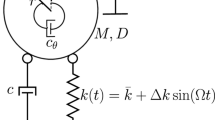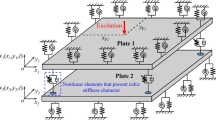Abstract
This study proposes a new method toward optimizing the design of non-conventional tuned mass dampers in multi-degree-of-freedom systems. An important application of the proposed method is in mega-sub-controlled structures in which the seismic vibration of the system is controlled by using isolated sub-structures. The method estimates the optimum parameters of the sub-structures including frequency ratio and damping ratio based on formulations derived for optimal design of SDOF systems with tuned mass dampers. The method is verified by comparing the results with a numerical method. It is shown that the proposed method returns the optimum parameters with acceptable accuracy (less than 5% difference from numerical results), and in some cases the results are identical to the numerical method. In the final part, the method is applied to three mega-structures with different control systems in order to examine its accuracy in predicting the optimum parameters of the non-conventional tuned mass dampers. It is concluded that the method is efficient and can be used for optimal design of such systems.









Similar content being viewed by others
References
Bakre SV, Jangid RS (2007) Optimum parameters of tuned mass damper for damped main system. Struct Control Health Monit 14(3):448–470
Bekdaş G, Nigdeli SM (2013) Mass ratio factor for optimum tuned mass damper strategies. Int J Mech Sci 71:68–84
Bekdaş G, Nigdeli SM (2017) Metaheuristic based optimization of tuned mass dampers under earthquake excitation by considering soil-structure interaction. Soil Dyn Earthq Eng 92:443–461
De Angelis M, Perno S, Reggio A (2012) Dynamic response and optimal design of structures with large mass ratio TMD. Earthq Eng Struct Dyn 41(1):41–60
Feng MQ, Mita A (1995) Vibration control of tall buildings using mega subconfiguration. J Eng Mech 121(10):1082–1088
Frahm H (1911) U.S. Patent No. 989,958. U.S. Patent and Trademark Office, Washington, DC
Hartog DJ (1956) Mechanical vibrations. McGraw-Hill, New York
Lin CC, Wang JF, Ueng JM (2001) Vibration control identification of seismically excited MDOF structure-PTMD systems. J Sound Vib 240(1):87–115
Marano GC, Greco R, Chiaia B (2010) A comparison between different optimization criteria for tuned mass dampers design. J Sound Vib 329(23):4880–4890
Matta E, De Stefano A (2009) Robust design of mass-uncertain rolling-pendulum TMDs for the seismic protection of buildings. Mech Syst Signal Process 23(1):127–147
Pan TC, Ling SF, Cui W (1995) Seismic response of segmental buildings. Earthq Eng Struct Dyn 24(7):1039–1048
Pinkaew T, Lukkunaprasit P, Chatupote P (2003) Seismic effectiveness of tuned mass dampers for damage reduction of structures. Eng Struct 25(1):39–46
Rana R, Soong TT (1998) Parametric study and simplified design of tuned mass dampers. Eng Struct 20(3):193–204
Sadek F, Mohraz B, Taylor AW, Chung RM (1997) A method of estimating the parameters of tuned mass dampers for seismic applications. Earthq Eng Struct Dyn 26(6):617–636
Soong TT, Dargush GF (1997) Passive energy dissipation systems in structural engineering. Wiley
Tian Z, Qian J, Zhang L (2008) Slide roof system for dynamic response reduction. Earthq Eng Struct Dyn 37(4):647–658
Vakakis AF, Paipetis SA (1986) The effect of a viscously damped dynamic absorber on a linear multi-degree-of-freedom system. J Sound Vib 105(1):49–60
Villaverde R (1985) Reduction seismic response with heavily-damped vibration absorbers. Earthq Eng Struct Dyn 13(1):33–42
Villaverde R (2002) Aseismic roof isolation system: feasibility study with 13-story building. J Struct Eng 128(2):188–196
Warburton GB (1982) Optimum absorber parameters for various combinations of response and excitation parameters. Earthq Eng Struct Dyn 10(3):381–401
Xiang P, Nishitani A (2015) Optimum design and application of non-traditional tuned mass damper toward seismic response control with experimental test verification. Earthq Eng Struct Dyn 44(13):2199–2220
Yahyai M, Zebarjad L, Head M, Shokouhian M (2019) Optimum parameters for large mass ratio TMDs using frequency response function. J Earthq Eng 24(1):1–20
Author information
Authors and Affiliations
Corresponding author
Appendix
Rights and permissions
About this article
Cite this article
Yahyai, M., Zebarjad, L., Head, M. et al. Toward Optimizing Dynamic Characteristics of Non-conventional TMDs in Multi-degree-of-Freedom Systems. Iran J Sci Technol Trans Civ Eng 44 (Suppl 1), 205–215 (2020). https://doi.org/10.1007/s40996-019-00338-z
Received:
Accepted:
Published:
Issue Date:
DOI: https://doi.org/10.1007/s40996-019-00338-z




